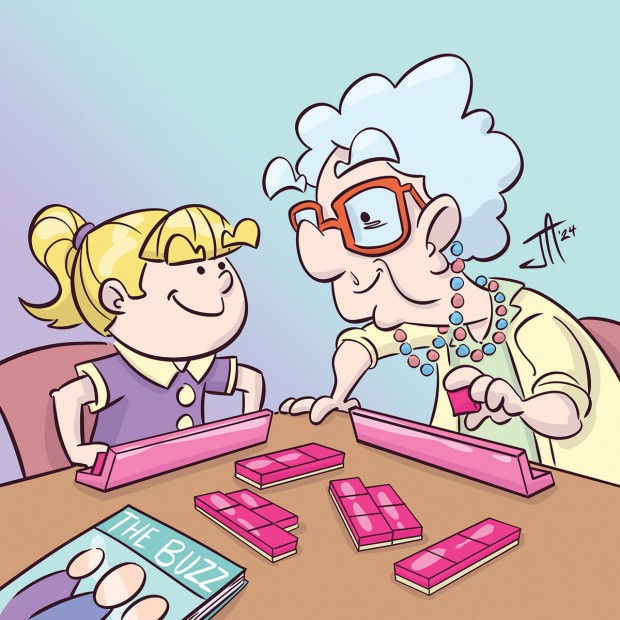The Game of the Summer: Mahjong takes over


QUICK LEARNER Whether it’s mahjong or Monopoly, multi-generational games are one of the joys of summer. (Illustration: behance.net/runamokstudios)
There’s an old new game in town, and I think I might be one of the last to jump in and play.
Mahjong is a centuries-old game that came to the United States from China in the 1920s – I remember my grandmother playing. Without knowing how to play the game, I loved stacking the solid white tiles engraved with beautiful and mysterious-to-me Chinese characters and symbols. More than 100 years after its American debut, mahjong is less granny glasses and more Aperol spritzes.
It was some 15 years ago when my (then) very young daughters’ grandmother taught them how to play. She gave one of them a sparkly pink mahjong set (glitter-coated tiles, pink acrylic tile racks, and a big pink bag to keep it all organized, all of which no eight-year-old could resist) and regularly pulled together games to entertain the girls. Mahjong requires four players (unless, I know now, you play with “Beulah,” the invisible extra who gives away jokers willy-nilly, because she isn’t real and doesn’t have a brain), so sometimes I would be drafted into the game. I was not interested.
If you haven’t played, mahjong is truly another language, one that takes a little concentration to master – more than I had in reserves as a young mom. Bams, cracks, dots? Flowers? Dragons? And blanks? What?
The rules are contrary to those in onze or gin or spades. At a lesson early on in my mahjong career (like a few months ago), one woman I was learning with – who happened to be from China – said, “I have a string of consecutive numbers in the same suit. I should be able to use these.” Alas. You must cull “hands” of tiles that correspond to the mahjong card of the year’s approved winning hands.
Which brings us to this: In order to keep up with the year-to-year scramble of what tiles constitute winning hands, you have to buy a new, trifold mahjong card every year. For $15. Which, my friends and I imagined, guaranteed that a bunch of mahjong-expert grannies in New York had a steady income, year after year. In reality, the National Mah Jongg League gives proceeds from the cards to charities.
Like so many hobbies, mahjong gained huge popularity during and after quarantine, when people had more down time and were craving connection.
“I think the appeal really is that it brings people face to face,” says Jacqui Kneese, a realtor at Compass. Jacqui is part of a group that gets together at the Houston Racquet Club every other week; although this summer, with more free time and kids who are a little more independent, they’ve gotten together as much as every other afternoon. “It’s nice,” she says, “because we’re from all different walks of life, our kids are different ages, at different schools. It’s fun and social and you can hang out and drink and avoid your family for a while, and you’re somewhat using your brain. Like pickleball but you don’t have to get sweaty.”
Having started playing just a few months ago, Jacqui says, “I’m very late to the trend. And I’m not playing to win. If someone wants to cheat, be my guest.”
That’s not to say there aren’t sticklers.
Heather Consoli, who started playing a couple of years ago and now plays every Thursday, explains: “The difference in mahjong players is like the difference between HLTA [Houston Ladies Tennis Association] tennis and Memorial [League] tennis. Memorial, everyone wants to know about your kids. HLTA is more like we’re gonna beat you and don’t talk to me. I’m Memorial League.”
The sorority rush consultant says, “I have a lot of younger friends who would laugh and ask me if I was going home to knit quilts after mahjong. But now it’s exploded, and all of them are playing, or they want to play. It’s just a great excuse to commit to being with friends.”
Which is, I guess, what finally got me in the game. Although I do have to remind myself every few minutes which tiles correspond to which suits.
For players like me, Jacqui says she knows several women whose full-time jobs are teaching people how to play mahjong. “I don’t know if they’re killing it,” she quips, “but they look like they eat.” If Jacqui’s group’s summer uptick in playtime is any indication, the mahjong coaches will be eating lobster and wagyu this summer.
Jacqui thinks a little more and adds, “Nobody has a knitting club anymore. Mahjong is the new knitting club.”
Want more buzz like this? Sign up for our Morning Buzz emails.
To leave a comment, please log in or create an account with The Buzz Magazines, Disqus, Facebook, or Twitter. Or you may post as a guest.


